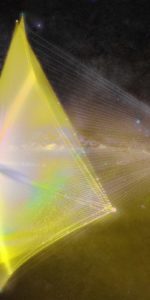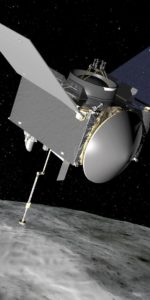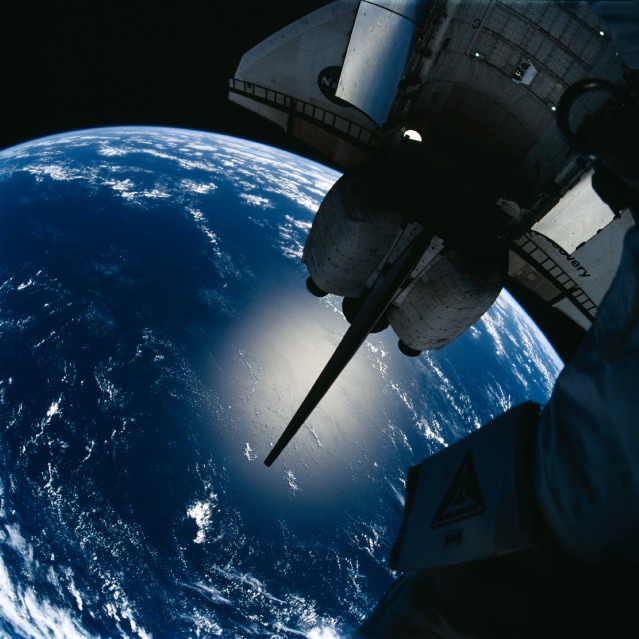
Fifteen years ago, this month, 10 astronauts and cosmonauts from the United States and Russia celebrated 1,000 days of orbital operations for the International Space Station (ISS). In August 2001, Shuttle Discovery’s STS-105 astronauts—Commander Scott “Doc” Horowitz, Pilot Rick “C.J.” Sturckow, and Mission Specialists Pat Forrester and Dan Barry—delivered the third resident crew to the fledgling outpost, supported a pair of critical EVAs, and returned to Earth with its outgoing second crew. Additionally, STS-105 transported over 7,000 pounds (4,000 kg) of equipment and supplies to the space station, aboard the Leonardo Multi-Purpose Logistics Module (MPLM).
Designated “Assembly Mission 7A.1,” STS-105 was inserted into the manifest relatively late, to accommodate tasks after the arrival of the Quest airlock on shuttle flight STS-104, Assembly Mission 7A. In the words of Dan Barry, 7A.1 was a dot flight, “where we really are trying to respond to the things that the station needs to have.” These “things” might include breakages or the appearance of specific issues and differed from “non-dot-flights”—7A or 8A, for instance—whose precise objectives and cargoes had been laid out several years before. “In some ways, it’s more interesting … to make some of these late changes,” said Barry. “It certainly is a challenge and we have trained for some things which, it turns out, we’re not going to do. But I think that’s part of business on being on space station and it’s rewarding when you get out there and do the task on short notice.”
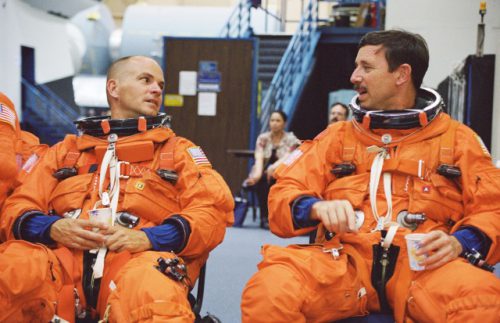
Unusually, crew trained to perform their two EVAs from the shuttle’s airlock, rather than from the newly-installed Quest. However, in the aftermath of Assembly Mission 6A in late April 2001—which installed “Canadarm2”—a series of subtle problems were detected with the station’s 57.7-foot-long (17.6-meter) robotic manipulator. These problems arose in May 2001, following a communications error between Canadarm2’s shoulder pitch joint and its main computer commanding unit.
Since the “Big Arm” was critically necessary to install Quest during shuttle flight STS-104 on Assembly Mission 7A, there existed a real possibility that STS-105 might end up flying first. “Right at a critical point in our training,” said Forrester, “there were some real questions about whether or not [Assembly Mission 7A] and, specifically, getting Quest installed was going to happen or not. We had to make a decision that we needed to continue training in a way that we knew we would be able to duplicate it on flight. And so, early on, we started designing our EVAs around the shuttle airlock, to be able to cover the contingency that we went before 104, or, in this case, after 104.”
As efforts to rectify Canadarm2’s woes continued through late May and into early June, STS-104 was postponed until no sooner than early July. Fortunately, on 20 June, NASA announced that its launch with Quest would go ahead on 12 July, allowing STS-105 to be formally scheduled for early August. “It wasn’t sure during training for STS-105 whether all the equipment necessary to install the airlock would be ready to support,” Horowitz told a NASA interviewer, in the weeks before launch. “So in order for us to train a mission, we had to sort of divorce ourselves from the 104 flight and obvious way to do that was to train to do our EVAs out of our airlock on the space shuttle.” By Horowitz’s own admission, the decision “gave us a little bit of a hit” with regard to efficiency in terms of transferring the spacewalkers between the ISS and the shuttle. “But it gained us the ability to plan and train and execute a spacewalk,” he added, “with a known configuration that, no matter when we flew, we would be able to support.”
“Coming out of the shuttle airlock means that the hatches between the shuttle and the space station have to be closed,” added Dan Barry. “And that kind of impact to our timeline we had to determine early on. If we waited until today, effectively, to determined that we did have [Quest] available, it’s really too late to make the final planning changes to our flight plan and to our EVAs.”
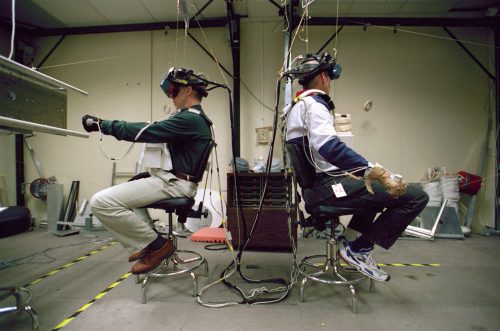
In addition to their EVAs, the STS-105 crew—named in December 2000 and originally targeted for launch in June 2001 (a tight, six-month training flow)—were tasked with exchanging two ISS increments. The Expedition 2 crew of Commander Yuri Usachev of Russia and his NASA flight engineers Jim Voss and Susan Helms would close out a multi-month stay about the station and be replaced by the Expedition 3 crew of Commander Frank Culbertson of NASA and his Russian flight engineers Vladimir Dezhurov and Mikhail Tyurin. “We haven’t had a lot of training with Expedition 3, because they’re so busy training for their increment,” said Horowitz before the flight. “We have had several exercises together. We’ve done a couple of integrated simulations together, where they simulate that they’re on the station or they’re on the shuttle getting ready to go to the station. We’ve done some training together over in the mockups, where we practice emergency egress training that we will have to do as a crew. Other than that, though, they’ve spent a lot of time in Russia in training for their increment.”
A further complication was that, for only the second time in the ISS assembly sequence, a dedicated shuttle crew would number only four members. Horowitz and Barry were joined by Sturckow and Forrester, with the remaining three seats aboard Discovery dedicated to the Expedition 3 crew for the uphill journey and to Expedition 2 for the return to Earth. This required the shuttle crew to adopt multiple tasks. For example, Horowitz assumed some RMS duties whilst the prime arm operator, Forrester, was outside on the mission’s two spacewalks. “It’s been a little bit of a training issue, because of all the time required to train to fly the arm, as well as do command duties,” Horowitz admitted, “but everybody’s pretty equally loaded. We’ve kind of spread the wealth around the crew to get everybody ready to do their tasks for this mission.”
The mission faced potential delay in early August 2001, when the health of an injector stem in a Hydraulic Power Unit (HPU) on the left-hand Solid Rocket Booster (SRB) came into question. Engineers suspected that the injector might have sustained cracking, caused by age-related stress corrosion, probably a result of repeated water immersion as the booster splashed down in the Atlantic Ocean after each of its previous launches. The possibility of replacing the suspect unit might have delayed STS-105’s launch by several days, but the Mission Management Team (MMT) concluded on 6 August that it was healthy and pressed ahead with countdown operations, tracking an opening launch attempt at 5:37 p.m. EDT on the 9th. However, high humidity and sea breezes threatened rain showers and a pall of ominous thunderclouds was observed off the end of the Shuttle Landing Facility (SLF) at the Cape. The latter would be needed in the unlikely event of a Return to Launch Site (RTLS) abort during ascent. At length, the launch attempt was called off at T-9 minutes.
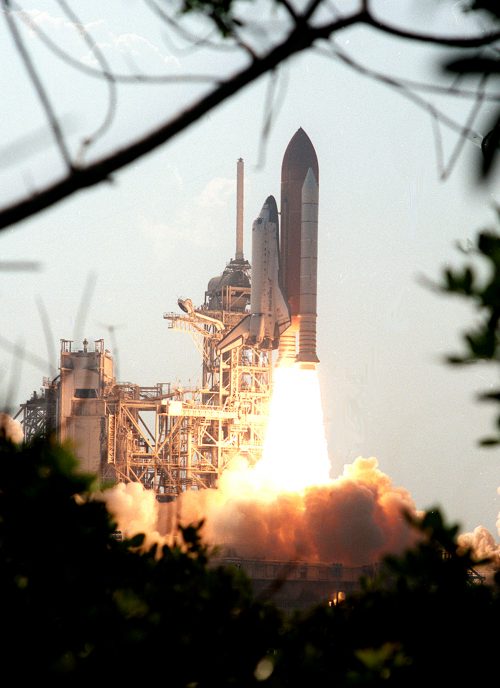
This offered a period of discomfort for the crew. “Getting into your spacecraft is akin to going out in the drive in the morning to your car,” Horowitz later joked, “except some joker overnight parked it on its rear bumper with the nose pointed in the air and you need about three people to push you up in the seat!” Next day, conditions had improved somewhat. “Tell the Expedition 2 guys to stand by,” Horowitz told Launch Director Mike Leinbach. “We’re on our way.”
Weather conditions threatened to deteriorate on 10 August, causing mission managers to move T-0 a few minutes earlier to 5:10 p.m. EDT, right on the opening of that day’s 10-minute “window.” And without further ado, Discovery roared aloft, kicking off the 106th flight of the shuttle program. “A significant event in your life,” was Horowitz’s description of the shake, rattle and roll of what was his fourth launch into space. Two minutes and five seconds after liftoff, the twin SRBs were jettisoned and, said Horowitz, “then, there’s a train-wreck,” as a bright flash and a clang enveloped Discovery’s cabin. The astronaut continued under the impulse of the three Space Shuttle Main Engines (SSMEs) for the next six minutes, until Main Engine Cutoff (MECO) and jettison of the External Tank (ET).
Shortly after orbital insertion, Sturckow noted that his Commander set to work devouring a pack of cheese tortellinis. “The rest of us weren’t feeling up to that,” the pilot wryly added, but this was nothing compared to the view of Discovery’s middeck, where the upcoming Expedition 3 crew had already begun science-gathering, with the “Effects of Altered Gravity on Spinal Cord Excitability” experiment, known as “H-Reflex,” which involved electrically stimulating the nerves in their legs as part of efforts to understand changes in locomotor function in weightlessness. “It looks like a lot of fun,” Sturckow said later, with a measure of sarcasm, “but we didn’t try it!”
As Horowitz and Sturckow oversaw the maneuvers, Barry and Forrester worked on the checkout of the Extravehicular Mobility Units (EMUs) for their two spacewalks. Early on the 12th, the shuttle had was about nine miles (15 km) from its quarry and had begun its final approach with the Terminal Initiation (TI) burn. Reaching 600 feet (180 meters), Horowitz assumed manual control of his ship and guided it through a quarter-circle to a point directly in “front” of the ISS, bearing toward the Pressurized Mating Adapter (PMA)-2 at the forward end of the U.S. Destiny lab. The maneuver was known as “TORVA”—a “Twice-Orbital-Rate +R-Bar to +V-Bar Approach”—which brought the shuttle from the Earth-radius-vector (R-bar) to a position along the station’s velocity vector (V-bar) for docking.
Inside Discovery’s cabin, the four STS-105 astronauts clustered together to bring the two spacecraft into a close mechanical embrace. As Horowitz floated near the aft flight deck controls, Sturckow oversaw a series of four “burns” from the Commander’s seat and Forrester monitored the trajectory. Meanwhile, Barry was occupied with a hand-held laser to determine range and rate-of-approach numbers. “And then, finally at the end, I’ll be looking out the window,” Barry told a NASA interviewer, before launch, “telling Scott Horowitz what the final very close distances are, so that when we get within just a few inches, we know the right time to make the contacts that we need to make to get a successful docking.”
Pausing at 30 feet (9 meters) to await a formal go-ahead from the Mission Control Centers (MCC) in Moscow and Houston, Texas, Horowitz then accomplished a smooth docking at 2:42 p.m. EDT. At the time of contact, the two spacecraft were about 240 miles (380 km) over northwestern Australia. “The connection is just the first part,” said Barry. “We then have to pull the pieces together; we have to pull the space station together with the orbiter and make an airtight seal.”
After two years of training for his expedition, Culbertson was eager to get on board the station. “C’mon, y’all, let’s go!” he urged his crewmates. After concluding a ballet of pressure and leak checks, the hatches were opened at 4:41 p.m. and the incumbent Expedition 2 crew—Commander Yuri Usachev and Flight Engineers Jim Voss and Susan Helms, who had been aboard the complex since March—welcomed their new visitors.
By his own admission, Forrester had no idea what to expect on his first spaceflight. However, he was presented with what he described as “a real unique opportunity.” In July 1993, when the U.S. Army sent him as an aerospace engineer to the Johnson Space Center (JSC) in Houston, Texas, Army astronaut Jim Voss was his first boss. “In fact, he was instrumental in bringing me down here,” Forrester remembered. “I feel I owe a lot to him, just the fact that I was selected. If you had told me, eight years ago, that I would eventually be on the shuttle, going up to bring him back from his stay on the space station, I just couldn’t have imagined it.”
The second part of this article will appear tomorrow.
Want to keep up-to-date with all things space? Be sure to “Like” AmericaSpace on Facebook and follow us on Twitter: @AmericaSpace




